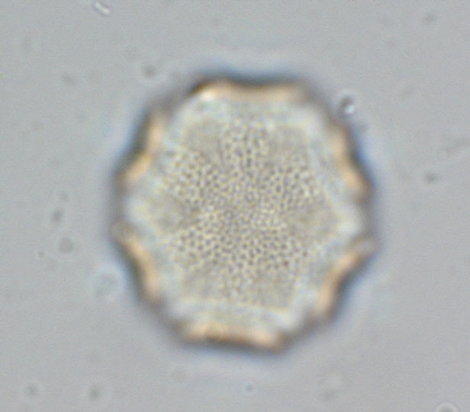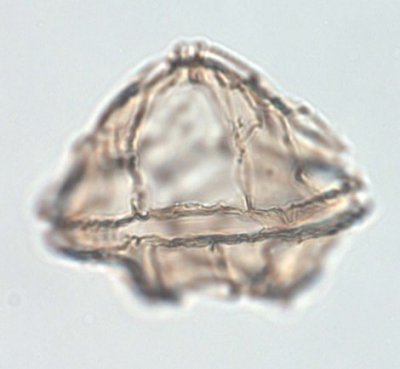- Home
- Karin Zonneveld
- Research topics
- Land-Sea correlation
Land-Sea correlation
Pollen and spores are produced by land plants have a species specific morphology. The sedimentary pollen/spores association can reflect vegetation in detail. Studying the pollen/spore content of sediment archives forms an ultimate tool to reconstruct past vegetation. Apart from natural forcing factors such as climate change, human activity can change vegetation significantly. Especially pollen of plants indicative for land-use can be used to reconstruct such activity.
In the marine sedimentary archives the pollen/spore association can reflect vegetation changes in their source area. Furthermore it can provide information about the character of their previous transport by rivers or wind. It can be used to trace past changes in wind direction and/or changes in discharge rates of rivers which can for instance be caused by changes in precipitation or melting of snow/ice.
Dinoflagellate cysts
Marine dinoflagellate cyst are produced by unicellular algae that live in the upper part of the water column. and can be found in all marine environments. They have a species specific morphology. It is well known that differential dinoflagellate species react very sensitively to changes in the trophic state of the upper waters and their fossilised sedimentary cyst associations are useful indicators of marine environmental conditions such as water temperature, salinity, turbulence/stratification, macro- and micronutrients (eutrophication) etc. Their sedimentary associations form therefore ultimate tools to reconstruct past marine environmental conditions.
Land-sea correlation
Combining the information derived from sedimentary pollen/spore and dinoflagellate associations provide information about contemporaneous climatic and environmental changes on the continent and in the marine realm.


Research Projects
Anthropogenic and natural coastal environmental change in southern Italy during the last 5 millenia (ANSIC)
PhD: Salvador Ruiz
The DFG funded project "ANSIC" is executed within the frame of the research activities of an international research group that investigates the natural and anthropogenic forcing of climate and environment in the Eastern Mediterranean during the last 5 millennia by integrating high resolution lacustrine and marine proxy records with climate and biogeochemical model experiments.
In this project, we study the impact of anthropogenic activity on climate, environment and sedimentary processes. Furthermore we establish a detailed land-sea correlation to tune environmental and climate change on the continent to changes in the marine repollen-spores and charcoal in marine and lacustrine environments are studied in relation to their transport ways, deposition centres and preservation. This to to understand the sensitivity of our methods.
Succesively we focus on the investigation of environmental changes during several pre-industrial key intervals such as for instance the occuring during the rise and fall of the Roman Empire. The comparison of instrumental data and literature based archeological and archeobotanical information with the compiled down-core data achieved with palynological, organic geochemical and sedimentological methods will be used to obtain information about the character and impact of human activity in the industrial and selected pre-industrial intervals.
Publications
Zonneveld, K.A.F. and Siccha, M. (2016). Dinoflagellate cyst based Modern Analogue Technique at test - a 300 year record from the Gulf of Taranto (Eastern Mediterranean). Palaeoclimatology, Palaeoecology, Palaeoceanography 450, 17-37.
Goudeau, M-L., Grauel, A-L., Tessarolo, C., Leider, A., Chen, L., Bernasconi, S.M., Versteegh, G.J.M., Zonneveld, K.A.F., Alonso-Hernandez, C.M., Boer, W. and de Lange, G.J. (2014) The Glacial-Interglacial transition and Holocene environmental changes in sediments from the Gulf of Taranto, Central Mediterranean. Marine Geology 348, 88-102.
Grauel, A-L., Leider, A., Goudeau, M-L., Müller, I,A., Bernasconi, S.M., Hinrichs, K-U., de Lange, G.J., Zonneveld, K.A.F., Versteegh, G.J.M. (2013) What do SST proxies really tell us? A high-resolution multiproxy UK37, TEX86 and foraminifera δ18O) study in the Gulf of Taranto,central Mediterranean Sea. Quaternary Science Reviews 73, 115-131
Chen L., Zonneveld K.A.F. and Versteegh G.J.M. (2013). Paleoclimate of the Southern Adriatic Sea region during the Medieval Climate Anomaly reflected by organic walled dinoflagellate cysts. The Holocene 23(5) 645 - 655.
Zonneveld, K.A.F., Chen, L., El-Shanawany, R., Fischer, H.W., Hoins, M. and Pittaurova, D. (2012) The use of dinoflagellate cysts to separate human-induced from natural variability in the trophic state of the Po River discharge plume over the last two centuries. Marine Pollution Bulletin 64, 114-132.
Chen L., Zonneveld K.A.F. and Versteegh G.J.M. (2011). Short term climate variability during the “Roman Classical Period” in the Eastern Mediterranean. Quaternary Science Reviews 30, 3880-3891.


